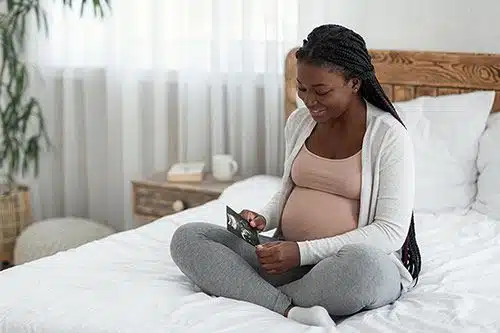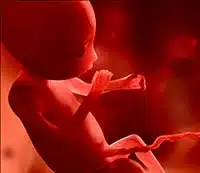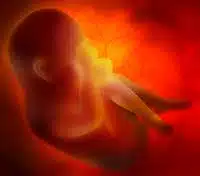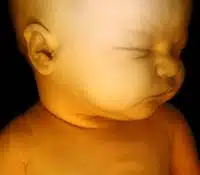
Once you understand what is going on “in there” during pregnancy, you will see why. Find out what’s happening with your baby’s development each month.
Fetal Development – First Trimester
The first trimester lasts from conception to 12 weeks, which is generally the first three months of pregnancy. During this trimester, your fertilized egg will change from a small grouping of cells to a fetus that is beginning to develop your baby’s features.
Month 1 (weeks 1 through 4)

In these first four weeks, the start of your baby’s face will begin to take form. Your baby’s mouth, throat, and lower jaw are developing during this time too. By the end of the first month, your baby will be about 1/4 inch long, and their tiny “heart” tube will beat 65 times a minute.
Month 2 (weeks 5 through 8)

Your baby’s brain, spinal cord, and central nervous system are well-formed during month two of pregnancy. Her sensory and digestive organs start to develop too, and bone starts to replace cartilage. At about six weeks, your doctor will be able to hear your baby’s heartbeat. By the end of week eight, your baby is about one inch long.
Month 3 (weeks 9 through 12)

Your baby is fully formed by the end of the third month; all of his organs and limbs are there and will continue to grow. His circulatory and urinary systems are also working, and his liver produces bile.
At the end of week 12, your baby is about four inches long and weighs about 1 ounce. Your chances of having a miscarriage will drop after three months since most of your baby’s fetal development has taken place by now.
Second Trimester
Many women say the second trimester is the best one because morning sickness has probably faded by now. Your baby will start to develop facial features, and you might start to feel movement as she flips and turns in your uterus.
During the second trimester, many women find out whether their baby will be a boy or girl. This is typically done by ultrasound at around 20 weeks.

In month four, your baby’s fingers, toes, eyelids, eyebrows, eyelashes, nails, and hair are formed. She can even suck her thumb, yawn, make faces, and stretch. Her nervous system is starting to work. By the end of week 16, your baby is about six inches long.
Month 5 (weeks 17 through 20)

Your baby’s hair will start to grow on her head. Her back, shoulders, and temples are covered by something called “lanugo,” a soft fine hair that protects her. Her skin is covered with a whitish coating called vernix caseosa to protect her skin from being exposed to the amniotic fluid.
By the end of month five, your baby is about 10 inches long and weighs from 1/2 to 1 pound.
Month 6 (weeks 21 through 24)

Your baby responds to sounds by moving, and you might feel jerking motions if your baby hiccups. By the end of week 24, your baby is about 12 inches long and weighs around two pounds.
Month 7 (weeks 25 through 28)

Fetal Development – Third Trimester
During the final stretch of pregnancy, many women are tempted to start the countdown to their due date and hope labor comes early. But this final stage of development is important because they help your baby for birth. Throughout the third trimester, babies gain weight quickly, adding body fat that will help them after birth.
Even though popular culture only talks about nine months of pregnancy, you may actually be pregnant for ten months. A full-term pregnancy is 40 weeks, which may take some women into the tenth month. Some women even go past their due date by a week or two.
Your doctor will monitor you closely as you get nearer to your due date, so that means more frequent appointments. If your due date has passed and you don’t go into labor, your doctor may use medications to make you go into labor and have the baby. Make sure to talk to your Adoption Coordinator and doctor during your trimester about your hospital and birth plan.
Month 8 (weeks 29 through 32)

Month 9 (weeks 33 through 36)
During this stage, your baby continues to grow and mature and your baby’s fetal development is almost complete. His lungs are almost fully developed at this point. Your baby can blink, turn his head, close his eyes, grasp firmly, and respond to sounds, light, and touch. He’s about 17 to 19 inches long and weighs from 5 ½ pounds to 6 ½ pounds.
Month 10 (Weeks 37 through 40)

Your baby is now ready to meet the world! They weigh about seven pounds and are 18 to 20 inches long.
Editor’s Note: This article was originally published on September 25, 2008, and has since been updated.
Mardie Caldwell, C.O.A.P., is nationally recognized as an expert on open adoption. A Certified Open Adoption Practitioner (C.O.A.P.), Caldwell is the founder of Lifetime Adoption Center, established in 1986. She has assisted in over 2,000 successful adoptions and was one of the first adoption professionals on the Internet.
Caldwell's life work is dedicated to educating and helping birth parents find the right adoptive parents for their child. She spreads the word about modern adoption through speaking appearances, webinars, online resources, and as a podcast show host.
She has written several award-winning books, including So I Was Thinking About Adoption, the first book of its kind. There are many reasons women choose adoption, and this short book is a comprehensive resource to make the best plan for you and your baby. Caldwell wrote So I Was Thinking About Adoption as a handy guide to the details of the adoption process.
Caldwell has made over 150 media appearances, including ABC News, CBS News, Larry King Live, CNN Headline News, NBC's The Today Show, CNN's The Campbell Brown Show, NBC News, KGO Newstalk Radio, CNN's Black in America II, MSNBC, Fox, PBS, BBC, and Dr. Laura.





0 Comments